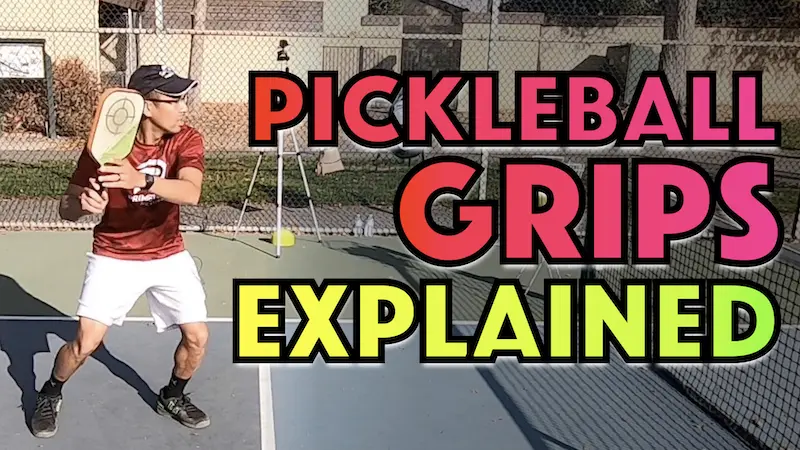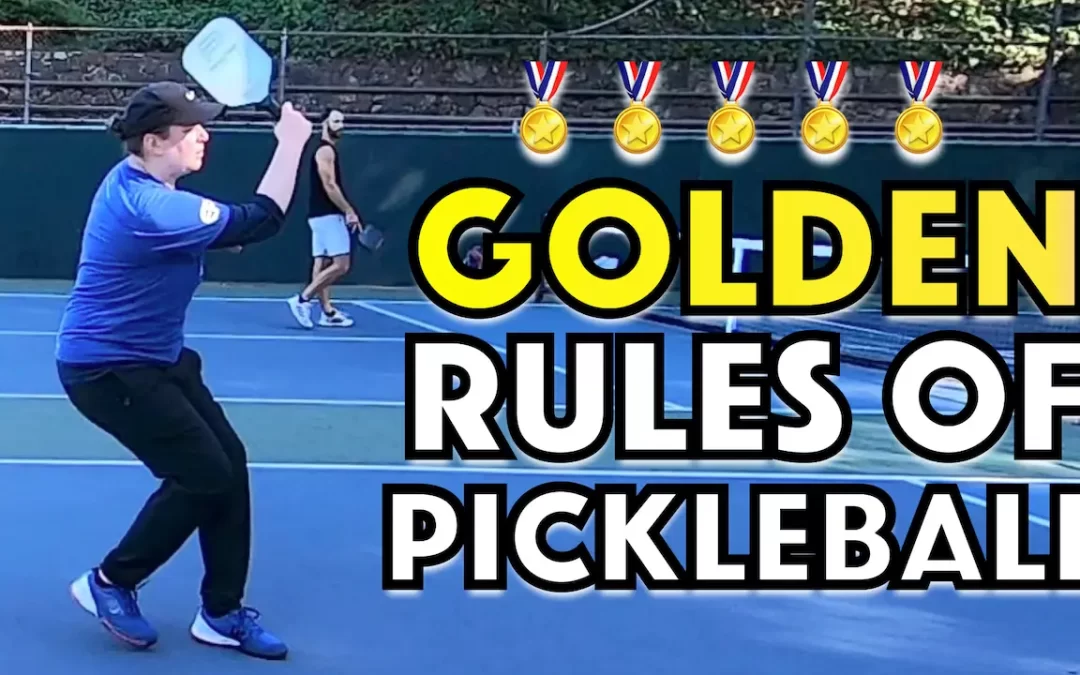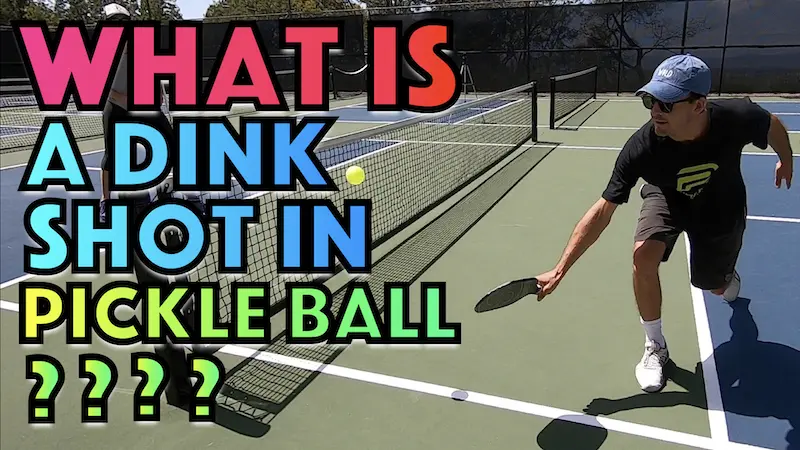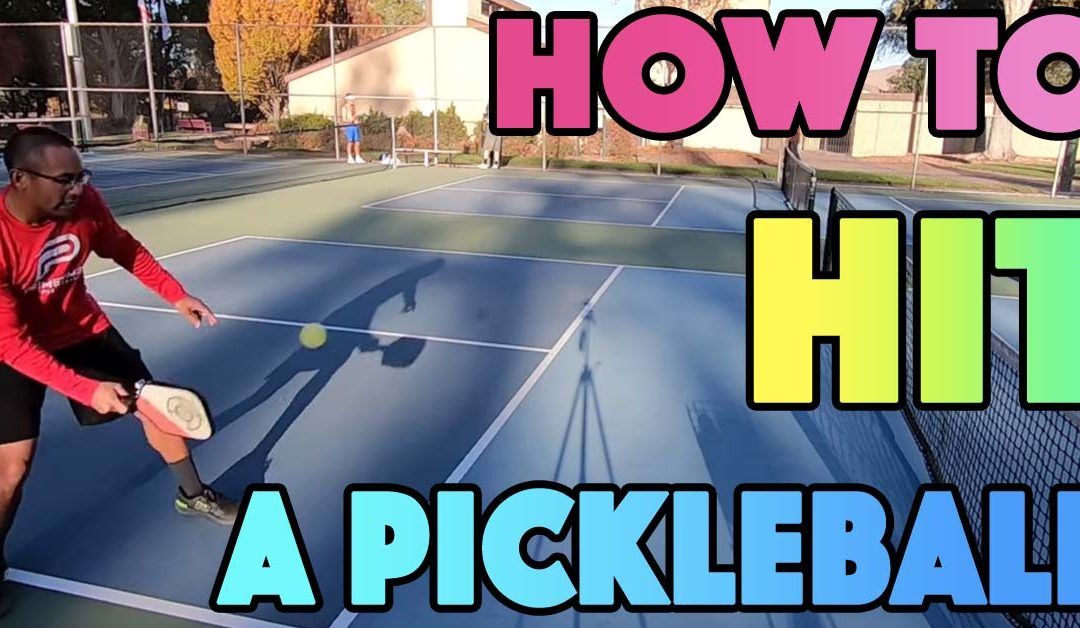When we talk about pickleball strategy we can really talk about three main things that we’re doing out on the pickleball court depending on the situation that you’re in.
Any time you’re out on the court, whether you realize it or not, you are doing one of these three things. The problem is that many players are doing them in the wrong order and at the wrong time.
We’re going to clear all that up today and break down exactly what the three core strategies are and exactly when you should be applying each one.
When it comes to these three strategies, I want to be clear that there is an order of execution to them. You can’t just apply them willy-nilly whenever you feel like it.
The situation dictates which strategy you pull out of your toolbox and apply.
You’ll easily know when to apply which one by a process of elimination. Let’s go through that.
Strategy #1 – Look To Attack First (Mindful Attacking)
Strategy number one is to look to attack first with the caveat being to only do so if there is an opportunity to do so.
You need to ask yourself – Is the other team weakened in some way at this moment? & Can I do something with this shot I have right now to strike a final blow that could lead to winning the point?
As a side note, I’m slowing this all down and breaking this all down so that it can be explained in detail. But, these questions I’m going to have you ask yourself, that will dictate which one of these three strategies you use, are all going to become automatic and happen very quickly in your mind when you realize how simple this is and apply it to your game.
This is all going to become second nature for you and you’ll easily decide in a split second what to do.
Then it just comes down to a matter of discipline and consistency of applying the right one at the right time. That’s the real secret.
Back to strategy number one, which can be also thought of as mindful attacking. This is an important one to really understand, accept, and apply.
I see many players attacking when the opportunity is just not right. An advantage has not yet been established in the point and yet players are going for winners through some tiny gap that barely exists or really doesn’t exist at all.
Players are out of position and running off the court and yet going for a down the line winner and they miss, or the opponent just knocks it back into the open court that they’ve left wide open for an easy winner.
There needs to be an advantage of some kind present for you to have the green light to go for an attack or a punishing shot of some kind.
For example, you hit an incredible deep serve and they send back a weak, high and short return…Great! They left you a cream puff just sitting up there.
Go for some blood and drive that sucker low and force them to come up with a super solid next shot.
That is an opportunity.
A player that gets a ball that’s just sitting up there, especially if you can step into it and your feet are going to be well in the court, then of course go for it.
I don’t care how good the other team on the other side is. If they must deal with pace on a shot that’s low on their body (see image below), then there’s not much damage at all that they can do with that.
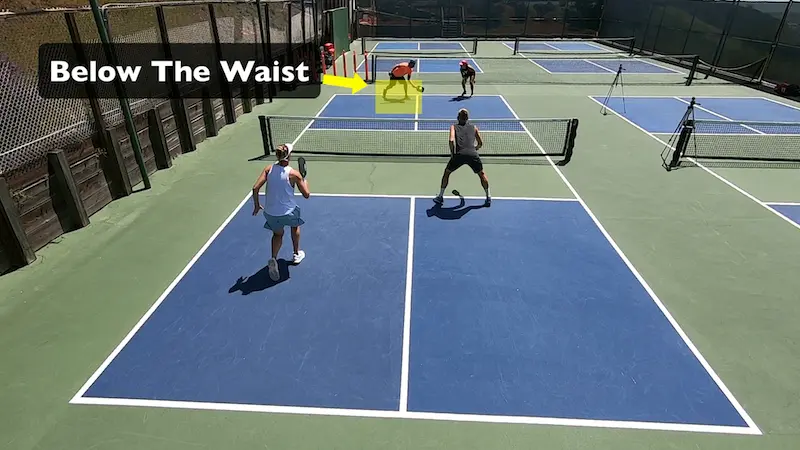
They’re most likely either going to send you back a neutral ball that isn’t attackable or one that you can attack again because they didn’t quite handle your shot that well.
The chances of you having to be on the defensive on the next ball are quite low.
Whenever you can drive it hard and get it low, you’re good to go on strategy number one as an offensive opportunity.
What you don’t want to do is to drive and give them a high contact point (see image below).
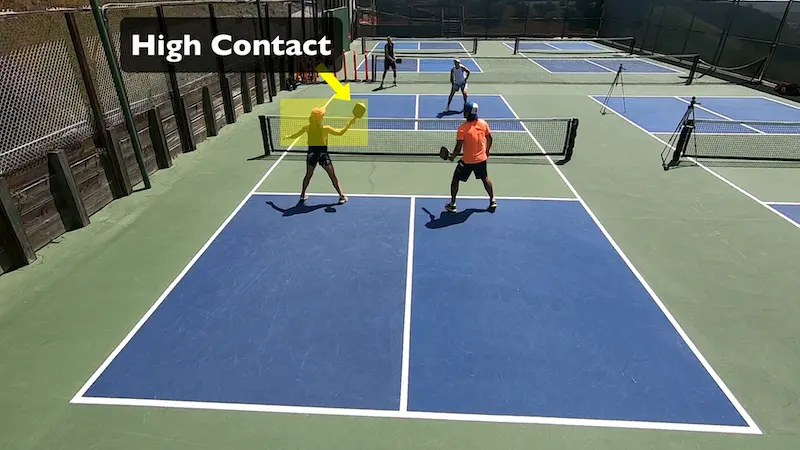
That gives them a chance to put you on the defense right away with a strong counterattack which makes sense for them because they have a high contact point.
The chances of them counterattacking and punishing you on that next ball have increased substantially in this situation.
So, if you have a shot that you’re confident you can drive hard and low… great! That’s an offensive opportunity. You can go ahead and take it at that point.
When you’re up at the non-volley zone line and you get high balls… Attack! Attack! Attack!
These are going to be your best opportunities in the point. Their side of the court is as exposed to you as it’s ever going to be so go for it even if they’re expecting it and are well positioned.
If you put a lot of pace on it and get it down on them or well away from them, you’re going to be in really good shape.
If they can’t get to it, you’ve won the point. If they can get to it and must deal with a hard shot and a low contact point while stretched (see image below), or even when they’re not stretched, you’re still in really good shape at that stage because even if they have good hands and block well, they typically can’t put you on the defensive on that next shot.
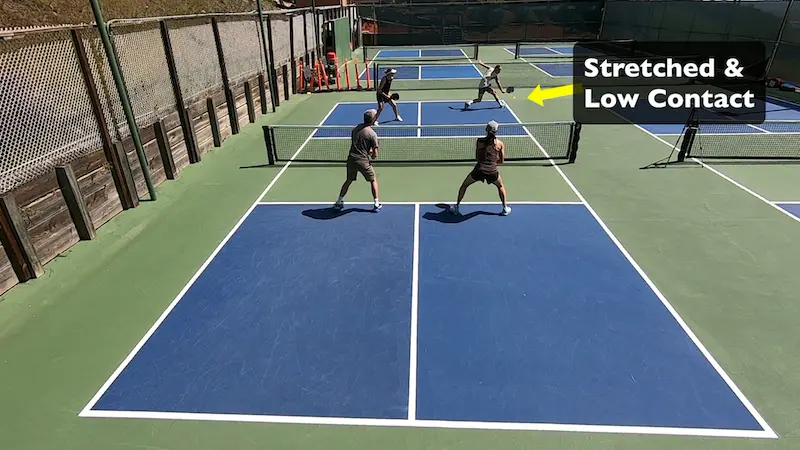
Occasionally will they deflect one and hit it on the line for a defensive block winner ? Sure. But don’t worry about that one-off random success here and there. Those are going to happen. The percentages are dramatically in your favour in that type of instance.
Routinely put them in situations where they can only beat you the most miraculous of defensive plays and you’re going to win those games like clockwork.
If you’ve been able to separate your opponents (see image below) or squeeze them together to create an opening, then send an attack through there. That’s another attacking opportunity that you have earned.
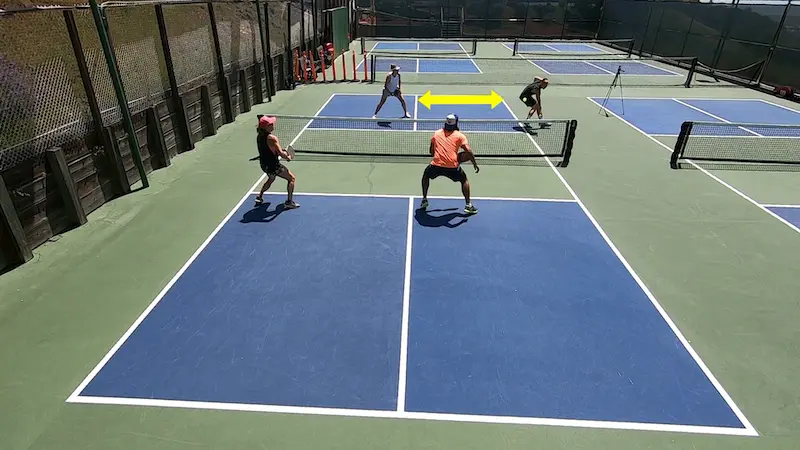
There’s the key word to all of this – you must have EARNED the right to attack in some way. Whether you developed it yourself or they just coughed it up to you.
An opening of some kind in the point must be present.
Look to attack first with the disclaimer that to be careful to only attack when in fact the opportunity is there for you to either win the point outright or put them on extreme defense or the best they can do is send you a neutralizing ball back.
That is mindful attacking, and you want to be looking to do that as your first priority.
If strategy number one is not available to you, which it often is not going to be, then you must ask yourself the next question – Okay I can’t attack right now but can I press them in some way that could then lead to an attackable ball? That’s strategy number two.
Strategy #2 – Look For Way To Press Opponents That Leads To A Potential Attack
What could those things be?
You can stretch them, you can jam them up in their body, you can stretch them and jam them as a pattern, etc.
You can do an offensive lob. That’s coming more and more into the game. Will that win the point outright? Maybe. But it’s not intended to.
Your goal is to push them back off the non-volley zone line and they’re going to run back and try to make a play on it.
Even if they do get it back, they’re now on big defense with their team two back and your team is two up and up at the non-volley zone line. You’re going to hammer them with overheads and high swinging volleys as much as possible to generate a winner or a forced error.
You set all that up with your pressing shot which in this case was the offensive lob.
If you’re in a dinking exchange, which often happens in the game, you’re going to want to hit a short dink, push one deeper, put one short again, and then short to the other side, and push one deeper on the other side, one into their feet and so on and so forth.
Move your dinks around to different locations with different spins and speeds to make them constantly have to adjust and recalibrate their shot.
Do all of this with the intention of pressing them.
Get them to be out of position and uncomfortable so that hopefully and ultimately that leads to them sending you something you can attack.
That’s key pickleball strategy number two. If you can’t attack them then try to press them if you can.
If both of those things are out of play because you yourself are on the defense and you’re not able to attack or press – you’re being pressed and you’re too busy trying to get the ball over and in as well as hopefully being unattackable – then that’s all you’re trying to do is to get out of that jam to try to neutralize the situation.
Strategy #3 – If You’re Being Attacked, Look To Neutralize The Situation
In situations when you’re uncomfortable and out of position then your objective is simply to get the ball over and in and get it low on them if you can.
Your number one goal at that phase of the point is to keep the point alive and the best way to do that is to get them into a low contact as soon as possible.
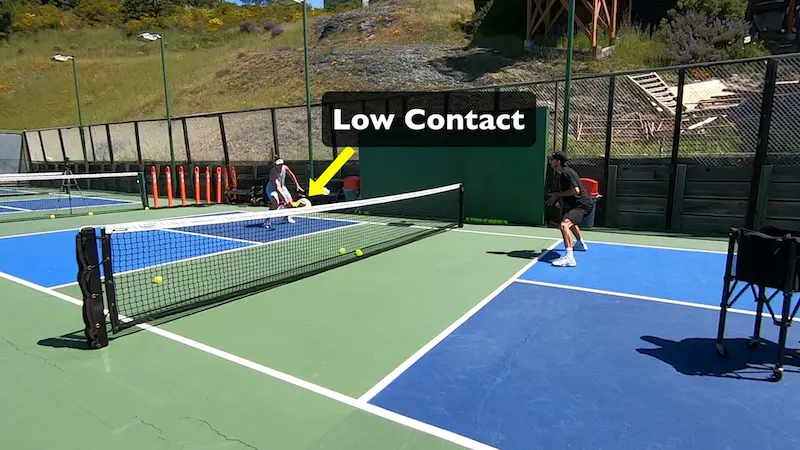
If they’ve attacked you and you’re at the non-volley zone line and you can’t reasonably counter attack because your contact point is too low on your body and the net’s going to make it tough for you to keep it low and you’re going to feed them a high contact point if you hit it hard.. that’s just going to put you in more trouble.
At that point hit a reset shot back into the kitchen which is just to block it back, let it bounce off your paddle and softly over the net so it’s short in the court and soft so that doesn’t come up into a high contact point.
If they can reach it with a volley, it’s still going to be low and even if it does bounce it’s not going to bounce too high.
That’s your best bet on a defensive play from the kitchen when you’ve been attacked.
This is also the time when the drop and the reset shot from mid court or further back come into play because the pickleball court is rather narrow and there aren’t too many gaps against players especially of higher caliber so there aren’t really that many opportunities to attack when your team is in the backcourt and their team is in the front of the court.
You can’t really press them unless it’s like we talked about earlier and they sat one up and you can drive it low on them and do some damage. But many times, that’s just not going to be the case when you’re in the backcourt.
So, when you find yourself in that phase of a point, and you will, then your number one goal is really to get it back and over the net and in play but get it low as best you can and as soon as you can.
If you can’t do it on the first defensive shot, do it on the second or the third. As soon as you can try to get it low so that you can bail yourself out of that position.
You’ll hit just a regular drop if the ball that came in was neutral or just slightly pressing or you’re going to hit a reset if you are quite pressed and on the defense.
The effect of the shot is really the same as far as a drop and a reset go.
It’s just that when you’re having to hit a reset, you’re generally a bit more pressed than if you’re having to hit a drop. It’s really the same difference. The shot you’re trying to send on them is relatively the same.
You’re not attacking them and you’re not pressing them you’re simply trying to prevent them from doing that to you on the next shot.
And, ideally, use that shot to come up to the non-volley zone line behind if you’ve hit a good one so that you can change the phase of the point from you being on deep defense to at least being on neutral and making some forward progress in the point by moving yourself from the back of the court to the front of the court.
Getting them into a low contact is just generally your best bet. It’s always a good idea especially when you’re trying to get out of a jam in the point.
One of the best skills of high level players is this – getting themselves out of a jam with great neutralizing shots that stay low.
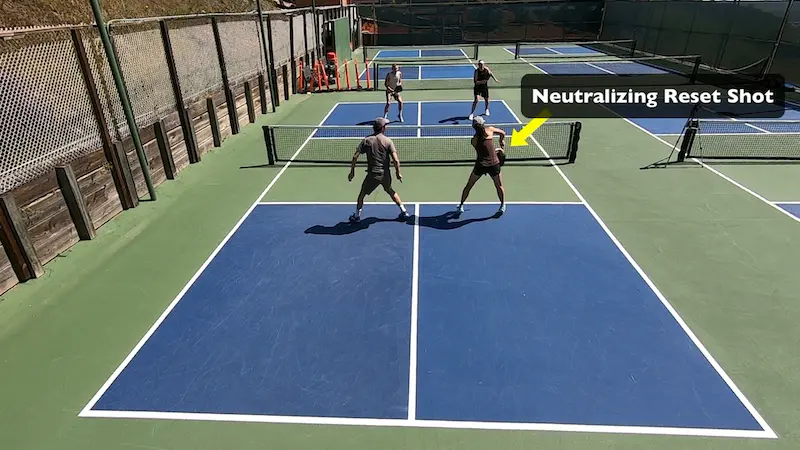
And if you’re at that phase of the point when you’re in a dink exchange and they’re pressing you with dinks then you’ll also send it back low.
Press them with your dinks as much as you can and if they’ve hit a good pressing dink on you, then again, just send a reset dink over, that above all else stays low, even if it doesn’t press them all that much.
And there we have it.
Number one is look to attack. If there is an opportunity to do so then great. Do that as much as you can but remember you must earn the right to attack. You can’t just attack whenever you feel like it because you’re bored or impatient or whatever.
High level players can and will make you pay for that if you attack at the wrong time.
You will get away with it in low levels of play for some time, but you’ll need to develop beyond that at some point if you hope to get the most out of your game.
If the attacking opportunity is not there, then press them as much as you can.
You may hit a good enough pressing shot from time to time that unintentionally becomes a winner because it was just that well struck and caught them off guard… but don’t bank on that because that wasn’t the goal of the shot.
Be clear about your intention and execution of your shot and let the results fall where they may.
And then, when you’re pressed and on defense, get it back over and get it back over low on them as soon as you possibly can because only then can you begin to work your way back into better positioning in the point and ultimately win it.
Unless they make an attacking mistake – they may miss one and over hit it. You’ll win some points that way but again that was not your intention.
You’re working the point to try to get back to neutral and then to offense.
At times, when you’re on big defense from the back of the court and hitting a controlled, accurate, low shot on them to try to get you out of trouble is just not realistic because you’re so very pressed and deep in the court and a shot like that would just be too tough. It is for the pros even at times.
In that case you send up a high defensive lob and get it as deep in the court as you possibly can, and you force them to try to beat you with overheads.
That’s the only case when you’re going to want to defend with the high shot, but it will happen and that’s a good idea at that time.
Sometimes just getting the ball back over the net is a win.
Scramble, scramble… get it over, get it over…until you can get one down and get back to neutral.
The better you are at that the more feared of a player you will be because it’s just so hard to win points on you even when you’re on big defense.
Those players are just tough to beat for everybody.
So pickleball really boils down to those three core strategies in a nutshell.
Can you attack?
Yes? Do it.
No? Press them.
Can you press them? Yes? Great go ahead and do that.
No? Okay just get it back and get it low as soon as you can.
It just always boils back down to that.
If you can do these three things and do them well then, you’ll go far with the game of pickleball.
How well do you do at each of these three strategies?
I’d love to hear about it so please let me know in the comments below.


